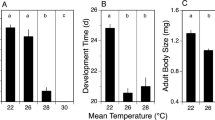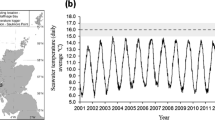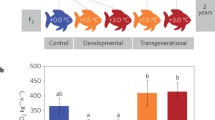Abstract
Understanding species’ responses to environmental challenges is key to predicting future biodiversity. However, there is currently little data on how developmental stages affect responses and also whether universal gene biomarkers to environmental stress can be identified both within and between species. Using the Antarctic clam, Laternula elliptica, as a model species, we examined both the tissue-specific and age-related (juvenile versus mature adult) gene expression response to acute non-lethal warming (12 h at 3 °C). In general, there was a relatively muted response to this sub-lethal thermal challenge when the expression profiles of treated animals, of either age, were compared with those of 0 °C controls, with none of the “classical” stress response genes up-regulated. The expression profiles were very variable between the tissues of all animals, irrespective of age with no single transcript emerging as a universal biomarker of thermal stress. However, when the expression profiles of treated animals of the different age groups were directly compared, a very different pattern emerged. The profiles of the younger animals showed significant up-regulation of chaperone and antioxidant transcripts when compared with those of the older animals. Thus, the younger animals showed evidence of a more robust cellular response to warming. These data substantiate previous physiological analyses showing a more resilient juvenile population.



Similar content being viewed by others
References
Ahn I-Y (1994) Ecology of the Antarctic bivalve Laternula elliptica (King and Broderip) in Collins Harbour, King George Island: benthic environment and adaptive strategy. Mem Natl Inst Polar Res Spec Issue 50:1–10
Altschul SF, Madden TL, Schaffer AA, Zhang JH, Zhang Z et al (1997) Gapped BLAST and PSI-BLAST: a new generation of protein database search programs. Nucl Acids Res 25:3389–3402
Arntz WE, Brey T, Gallardo VA (1994) Antarctic zoobenthos. In: Ansell AD, Gibson RN, Barnes M, editors. Oceanography and Marine Biology, An Annual Review. 32: 241–304
Bairoch A, Bougueleret L, Altairac S, Amendolia V, Auchincloss A et al (2007) The universal protein resource (UniProt). Nucl Acids Res 35:D193–D197
Benjamini Y, Hochberg Y (1995) Controlling the false discovery rate—a practical and powerful approach to multiple testing. J Roy Stat Soc B 57:289–300
Bertolotti A, Zhang YH, Hendershot LM, Harding HP, Ron D (2000) Dynamic interaction of BiP and ER stress transducers in the unfolded-protein response. Nat Cell Biol 2:326–332
Buckley BA, Gracey AY, Somero GN (2006) The cellular response to heat stress in the goby Gillichthys mirabilis: a cDNA microarray and protein-level analysis. J Exp Biol 209:2660–2677
Clark MS, Peck LS (2009) Triggers of the HSP70 stress response: environmental responses and laboratory manipulation in an Antarctic marine invertebrate (Nacella concinna). Cell Stress Chaperones 14:649–660
Clark MS, Fraser KPP, Peck LS (2008) Antarctic marine molluscs do have an HSP70 heat shock response. Cell Stress Chaperones 13:39–49
Clark MS, Thorne MAS, Vieira FA, Cardoso JCR, Power DM et al (2010) Insights into shell deposition in the Antarctic bivalve Laternula elliptica: gene discovery in the mantle transcriptome using 454 pyrosequencing. BMC Genomics 11:362
Clark MS, Husmann G, Thorne MAS, Burns G, Truebano M et al (2013) Hypoxia impacts large adults first: consequences in a warming world. Glob Chang Biol 19:2251–2263
Cook LM, Freeman PM (1986) Heating properties of morphs of the mangrove snail Littoraria pallescens. Biol J Linn Soc 29:295–300
Dahlhoff E, Somero GN (1993) Effects of temperature on mitochondria from abalone (genus Haliotis): adaptive plasticity and its limits. J Exp Biol 185:151–168
De Wolf H, Backeljau T, Verhagen R (1998) Spatio-temporal genetic structure and gene flow between two distinct shell morphs of the planktonic developing periwinkle Littorina striata (Mollusca: Prosobranchia). Mar Ecol Prog Ser 163:155–163
Dell RK (1972) Antarctic benthos. Adv Mar Biol 10:1–216
R Development Core Team (2005) R: a language and environment for statistical computing. R Foundation for Statistical Computing. Vienna, Austria. http://www.R-project.org
Drinkwater K (2009) Comparison of the response of Atlantic cod (Gadus morhua) in the high-latitude regions of the North Atlantic during the warm periods of the 1920s–1960s and the 1990s–2000s. Deep-Sea Res II 56:2087–2096
Drummond IAS, McClure SA, Poenie M, Tsein RY, Steinhardt RA (1986) Large changes in intracellular pH and calcium observed during heat shock are not responsible for the induction of heat shock proteins in Drosophila melanogaster. Mol Cell Biol 6:1767–1775
Fields PA, Zuzow MJ, Tomanek L (2012) Proteomic responses of blue mussel (Mytilus) congeners to temperature acclimation. J Exp Biol 215:1106–1116
Gestal C, Pallavicini A, Venier P, Novoa B, Figueras A (2010) MgC1q, a novel C1q-domain-containing protein involved in the immune response of Mytilus galloprovincialis. Dev Comp Immunol 34:926–934
Grange LJ, Tyler PA, Peck LS, Cornelius N (2004) Long-term interannual cycles of the gametogenic ecology of the Antarctic brittle star Ophionotus victoriae. Mar Ecol Prog Ser 278:141–155
Gunter HM, Degan BM (2008) Impact of ecologically relevant heat shocks in Hsp developmental function in the vetigastropod Haliotis asinina. J Exp Zool 310B:450–464
Husmann G, Philipp EER, Rosenstiel P, Vazquez S, Abele D (2011) Immune response of the Antarctic bivalve Laternula elliptica to physical stress and microbial exposure. J Exp Mar Biol Ecol 398:83–90
Husmann G, Abele D, Rosenstiel P, Clark MS, Kraemer L et al (2014) Age-dependent expression of stress and antimicrobial genes in the hemocytes and siphon tissue of the Antarctic bivalve, Laternula elliptica, exposed to injury and starvation. Cell Stress Chaperones 19:15–32
Kultz D (2005) Molecular and evolutionary basis of the cellular stress response. Ann Rev Physiol 67:225–257
Leadsham JE, Gourlay CW (2008) Cytoskeletal induced apoptosis in yeast. Biochim Biophys Acta, Mol Cell Res 1783:1406–1412
Lee CG, Da Silva CA, Dela Cruz CS, Ahangari F, Ma B et al (2011) Role of chitin and chitinase/chitinase-like proteins in inflammation, tissue remodeling, and injury. Ann Rev Physiol 73:479–501
Lockwood BL, Sanders JG, Somero GN (2010) Transcriptomic responses to heat stress in invasive and native blue mussels (genus Mytilus): molecular correlates of invasive success. J Exp Biol 213:3548–3558
Mardia KV, Kent JT, Bibby JM (1979) Multivariate analysis. Academic, London
Morley SA, Peck LS, Miller AJ, Portner HO (2007) Hypoxia tolerance associated with activity reduction is a key adaptation for Laternula elliptica seasonal energetics. Oecologia 153:29–36
Pantzartzi C, Drosopoulou E, Yiangou M, Drozdov I, Tsoka S et al (2010) Promoter complexity and tissue-specific expression of stress response components in Mytilus galloprovincialis, a sessile marine invertebrate species. PLoS Comp Biol 6, e1000847
Parkinson J, Anthony A, Wasmuth J, Schmid R, Hedley A et al (2004) PartiGene—constructing partial genomes. Bioinformatics 20:1398–1404
Peck LS, Portner HO, Hardewig I (2002) Metabolic demand, oxygen supply, and critical temperatures in the Antarctic bivalve Laternula elliptica. Physiol Biochem Zool 75:123–133
Peck LS, Webb KE, Bailey DM (2004) Extreme sensitivity of biological function to temperature in Antarctic marine species. Func Ecol 18:625–630
Peck LS, Morley SA, Portner HO, Clark MS (2007) Thermal limits of burrowing capacity are linked to oxygen availability and size in the Antarctic clam Laternula elliptica. Oecologia 154:479–484
Peck LS, Clark MS, Morley SA, Massey A, Rossetti H (2009) Animal temperature limits and ecological relevance: effects of size, activity and rates of change. Func Ecol 23:248–256
Peck LS, Souster T, Clark MS (2013) Juveniles are more resistant to warming than adults in 4 species of Antarctic marine invertebrates. PLoS One 8, e66033
Pertea G, Huang XQ, Liang F, Antonescu V, Sultana R et al (2003) TIGR Gene Indices clustering tools (TGICL): a software system for fast clustering of large EST datasets. Bioinformatics 19:651–652
Petalidis L, Bhattacharyya S, Morris GA, Collins VP, Freeman TC et al (2003) Global amplification of mRNA by template-switching PCR: linearity and application to microarray analysis. Nucl Acids Res 31, e142
Philipp EER, Husmann G, Abele D (2011) The impact of sediment deposition and iceberg scour on the Antarctic soft shell clam Laternula elliptica at King George Island. Antarct Antarct Sci 23:127–138
Purac J, Burns G, Thorne MAS, Grubor-Lajsic G, Worland MR et al (2008) Cold hardening processes in the Antarctic springtail, Cryptopygus antarcticus: clues from a microarray. J Insect Physiol 54:1356–1362
Ralph R, Maxwell JGH (1977) Growth of 2 Antarctic Lamellibranchs—Adamussium colbecki and Laternula elliptica. Mar Biol 42:171–175
Richie ME, Silver J, Oshlack A, Holmes M, Diyagama D, Holloway A, Smyth GK (2007) A comparison of background correction methods for two colour microarrays. Bioinformatics 23:2700–2707
Schmidt-Nielsen K (1991) Animal physiology: adaptation and environment. Cambridge University Press, Cambridge
Smyth GK (2004) Linear models and empirical Bayes methods for assessing differential expression in microarray experiments. Stat Applic Genet Mol Biol 3:3
Smyth GK (2005) Limma: linear models for microarray data. Gentalman R, Carey VJ, Huber W, Irizarry RA, Dudoit S, editors. 397–420 p
Smyth GK, Speed T (2003) Normalization of cDNA microarray data. Methods 31:265–273
Smyth GK, Michaud J, Scott HS (2005) Use of within-array replicate spots for assessing differential expression in microarray experiments. Bioinformatics 21:2067–2075
Somero GN (2010) The physiology of climate change: how potentials for acclimatization and genetic adaptation will determine ‘winners’ and ‘losers’. J Exp Biol 213:912–920
Sørensen JG, Loeschcke V (2007) Studying stress responses in the post-genomic era: its ecological and evolutionary role. J Biosci 32:447–456
Tomanek L (2011) Environmental proteomics: changes in the proteome of marine organisms in response to environmental stress, pollutants, infection, symbiosis, and development. Ann Rev Mar Sci 3:373–399
Truebano M, Burns G, Thorne MAS, Hillyard G, Peck LS et al (2010) Transcriptional response to heat stress in the Antarctic bivalve Latemula elliptica. J Exp Mar Biol Ecol 391:65–72
Venables WN, Ripley BD (2002) Modern applied statistics. Springer, Berlin
Walker ST, Mantle D, Bythell JC, Thomason JC (2000) Oxidative-stress: comparison of species specific and tissue specific effects in the marine bivalves Mytilus edulis (L.) and Dosinia lupinus (L.). Comp Biochem Physiol B 127:347–355
Waskiewicz AJ, Flynn A, Proud CG, Cooper JA (1997) Mitogen activated protein kinases activate the serine/threonine kinases Mnk1 and Mnk2. EMBO J 16:1909–1920
Yu ZF, Luo H, Fu WM, Mattson MP (1999) The endoplasmic reticulum stress-responsive protein GRP78 protects neurons against excitotoxicity and apoptosis: suppression of oxidative stress and stabilization of calcium homeostasis. Exp Neurol 155:302–314
Acknowledgments
This paper was funded by NERC core funding to BAS within the Polar Sciences for Planet Earth Programme. We would like to thank the Rothera Dive Team for help in collecting animals. The NERC National Facility for Scientific Diving (Oban) provided overall diving support. We would also like to thank three anonymous reviewers for their very constructive comments and additional references, which have greatly improved the manuscript.
Author information
Authors and Affiliations
Corresponding author
Rights and permissions
About this article
Cite this article
Clark, M.S., Thorne, M.A.S., Burns, G. et al. Age-related thermal response: the cellular resilience of juveniles. Cell Stress and Chaperones 21, 75–85 (2016). https://doi.org/10.1007/s12192-015-0640-x
Received:
Revised:
Accepted:
Published:
Issue Date:
DOI: https://doi.org/10.1007/s12192-015-0640-x




